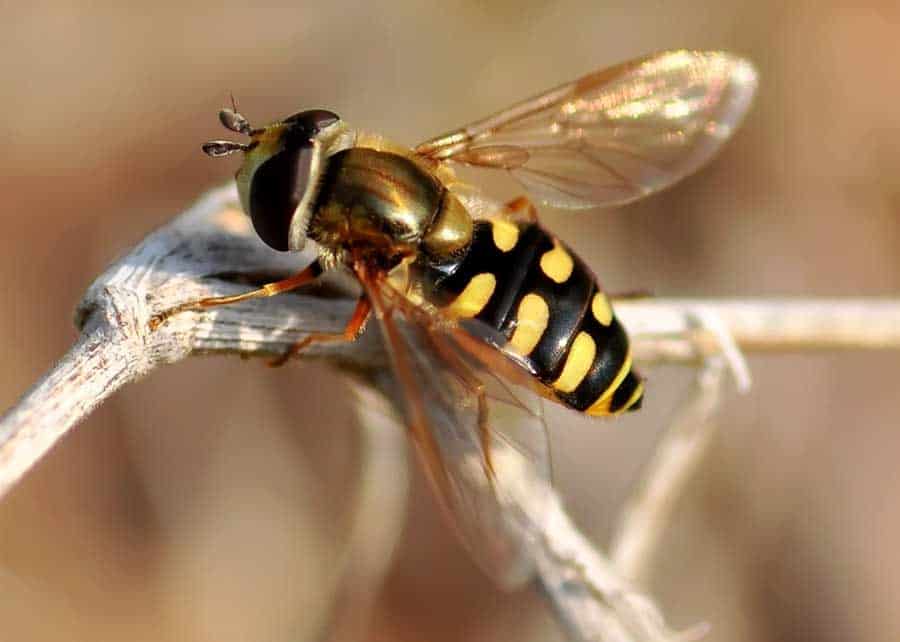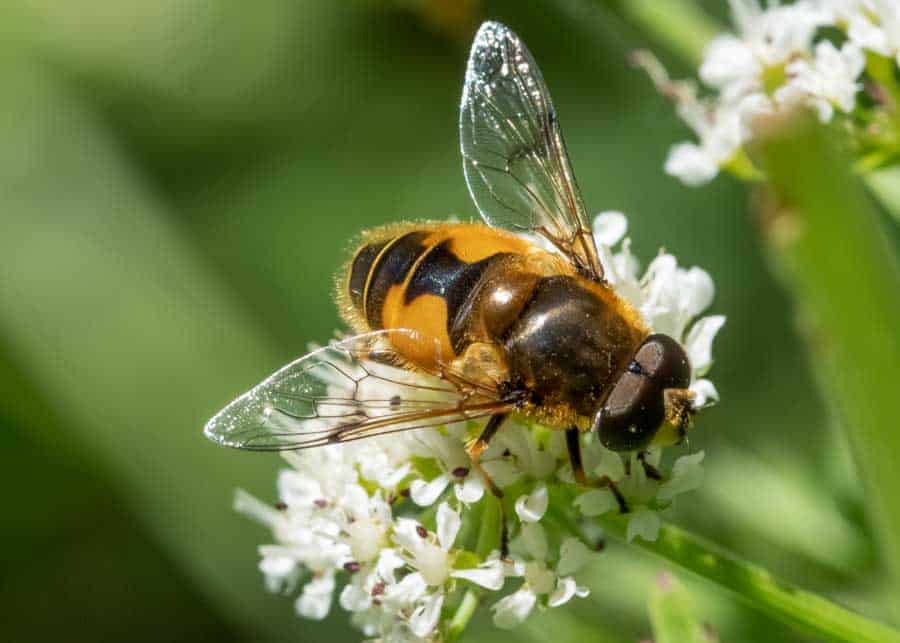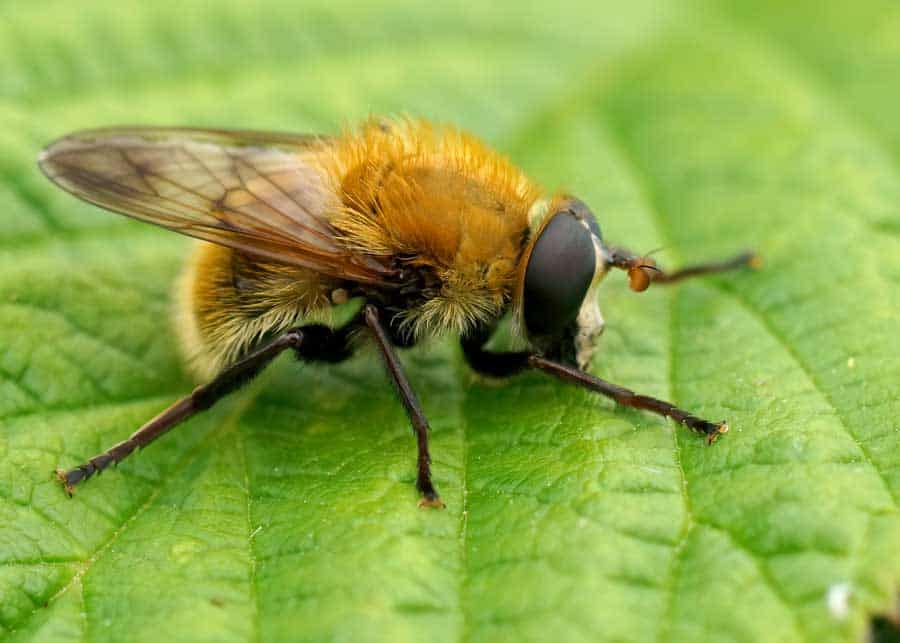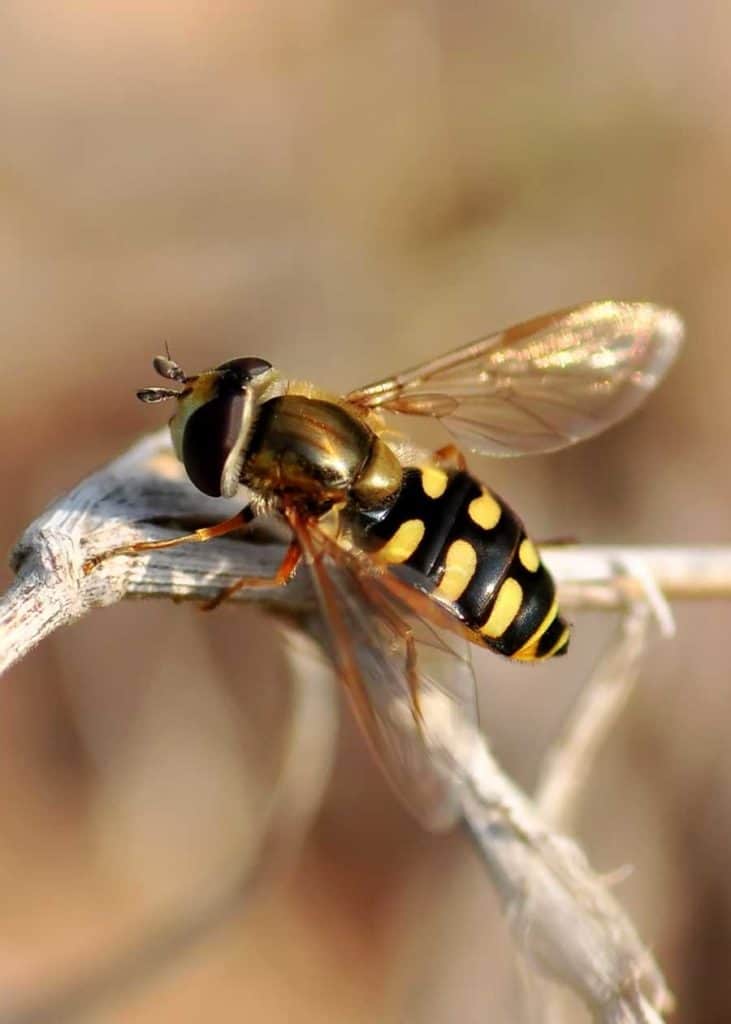Syrphid flies are beneficial garden insects. Their larvae eat both insects and fungi, depending on the species. And adult hover flies are proficient pollinators around the earth.
You will commonly see this tiny fly collecting nectar on flowers in your garden. Adult hover flies collect both pollen and nectar. And hover flies are one of just a few insects that can digest pollen.

Table of Contents
Guide to Hover Flies
Hover flies are from the insect family Syrphidea.
Hover flies are also known as flower flies or syrphid flies.
In this post, we’ll use these three names interchangeably.
Species of Hover Flies
There are 6,000 hover fly species across 200 genera.
Hover flies can be found around the world, on all continents except Antarctica.
Are Hover Flies Harmful?
Hover flies are harmless to humans and most mammals. Some hover fly larva are insectivores and will hunt common garden pests, like aphids and other plant-sucking insects.
This action makes the hover fly a beneficial insect predator.

What Do Syrphid Flies Look Like?
There are a few commonalities among the 6000 known species of hover flies.
- All hover flies have a single pair of functional wings, making them true flies.
- Most syrphid flies have a false (spurious) vein that runs parallel to their fourth longitudinal wing vein.
- Many syrphid fly species resemble wasps or bees with visible yellow or brown bands or spots on their bodies. This feature causes them to be mistaken for their stinging relatives, serving as protection from many predators. This is known as Batesian mimicry.
- Hover flies can often be seen hovering in mid-air and above flowers. This ability is how they got their name.
Varying Appearances of Hover Flies
While many hover flies look like bees or wasps, some have very distinct appearances.
- Criorhina genus: These are large and hairy flies. These hoverflies are medium to large in size, and often black, green, or yellow in color, resembling bumblebees. Despite their similarly hairy appearance, these aren’t to be confused with the much slower-moving tachinid fly.
- Baccha genus: These hoverflies are small and delicate-looking, often resembling wasps.
- Drone flies (Eristalis tenax): This migratory species is the most widely distributed of all syrphid species on earth.

Hover Fly Size
The size of hoverflies varies dramatically across species. They can range in size from 1⁄8 to 13⁄16 inches long (3 to 21 mm).
Here are two extremes, from one of the smallest hover flies to one of the largest:
- Paragus tibialis: Size ranges from 1⁄8 to 13⁄64 inches long (3-5 mm). This species is found in Europe and North Africa.
- Criorhina nigriventris: The bare-cheeked bumble fly size ranges from 17⁄32 to 13⁄16 inches long (13 to 21 mm). This species is found in the northern United States and southern Canada.
Benefits of Hover Flies
Hover flies provide two key benefits.
- Pollination: Syrphid flies are important pollinators around the planet. This is why they are also known as “flower flies”. They are often considered one of the most important pollinators, second only to wild bees.
- Pest control: Hover fly larvae (maggots) prey on many harmful insects. These include aphids, thrips, and other insects that harm plants.
Hover fly larva helps keeps milkweed-eating insects in check. A single larva can eat hundreds over aphids in one month.
Other syrphid fly maggots prefer fungi over insects. These species also provide a helpful service to your garden.
Remember: If you spot a hover fly in your garden, they are beneficial and they don’t sting.

If you are growing milkweed for monarchs to lay eggs on, hover flies can help keep those harmful insects in check.
Your Turn
Have you seen hoverflies in your garden? Are you actively attracting them to your garden? I would love to hear your experience in the comments below.
- About the Author
- Latest Posts
Bryan Haines is a co-founder and writer at The Buginator. And is working to make it the best resource for taking back the outdoors from biting, stinging pests.
He also blogs about travel at Storyteller.Travel and photography at Storyteller Tech. Bryan is a partner at Storyteller Media, a publishing company he runs with his wife, Dena.

Tom Barkas
Tuesday 13th of June 2023
Think I’ve just seen a hoverfly cutting the pollen ends off stamens of a honeysuckle!